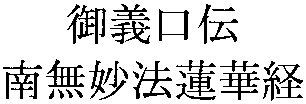The Oral Transmission on the Significance Ongi kuden, The first day of the first month of the first year of Kô,an [1278] at 57 years of age The Oral Transmission states that Nam is a Sanskrit word which is said to be ‘to consecrate and found one's life on'. In what we found our lives on and consecrate them to, there is both the person and the dharma. The person is the Shakyamuni to whom we dedicate our lives and on whom we make our foundation. The dharma is the Dharma Flower Sutra on which we found our lives and to which they are dedicated. It also says that ‘to consecrate' means we turn our lives towards the intrinsicality of the real suchness that is immutable in essence and belongs to the temporary gateway. ‘Our lives' refers to a life founded in the wisdom of the real suchness as it is according to the circumstances and is a concept of the original gateway. This consecration and making it a foundation of our lives is Nam myôhô renge kyô [the consecration and founding of our lives on the Sutra on the Lotus Flower of the Utterness of the Dharma]. This is explained as, ‘both the real suchness as it is according to the circumstances and the real suchness that is immutable in essence are contained in the shortest instant of mind'; it is the wisdom that shines with the real intrinsicality. It also says that ‘to consecrate' are the dharmas of our materiality and that ‘our lives' are the dharmas of our minds. So that both our materiality and minds are the oneness of the ultimate Buddha terrain. This is explained in the Explanatory Notes on the Recondite Significance of the Dharma Flower , ‘We take refuge in the oneness of the ultimate Buddha terrain because it is called the Buddha vehicle.' There is also the explanation that the Nam of Nam myôhô renge kyô is Sanskrit and that Myôhô renge kyô is classical Chinese. Nam myôhô renge kyô is said to be simultaneously both Sanskrit and classical Chinese. It is also stated that in Sanskrit it is Saddharma Pundarîka Sutram. Here we call it Myôhô renge kyô [the Sutra on the Lotus Flower of the Utterness of the Dharma]. Sat is Utterness [myô], Dharma is hô in Japanese, Pundarîka is the Lotus Flower [renge] and Sutram [kyô] means Sutra. The nine ideograms for the nine syllables of Saddharma Pundarîka Sutram are the Buddha entity that is made up of the Nine World Honoured Ones which symbolize the nine realms of dharmas not being separate from the Buddha realm. Utterness [myô] is the dharma nature and dharmas [hô] are their respective unenlightenment. The single entity of unenlightenment and the dharma nature are called the Utterness of the Dharma [myôhô]. The lotus flower [renge] is the two dharmas of cause and effect as a single simultaneous event. Sutra [kyô] is said to be all the speech, words, utterances and voices of all sentient beings. This is explained as, ‘When the voice becomes the transmission of the Buddha Dharma it is called a Sutra.' By being constant throughout the past, present and future it is called a Sutra. The realm of the dharmas or the Dharma realm is the Utterness of the Dharma. The realm of the dharmas is the Lotus Flower. The realm of the dharmas is the Sutra. The Lotus Flower is the Buddha entity of the Nine World Honoured Ones in the eight-petalled lotus. You must ponder over this thoroughly. Martin Bradley, The Buddha Writings of Nichiren Daishonin, ISBN: 2-913122-19-1, 2005, Chapter 1, p. 105 |
|

